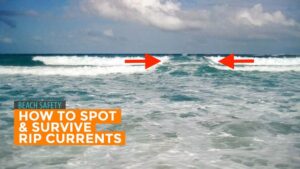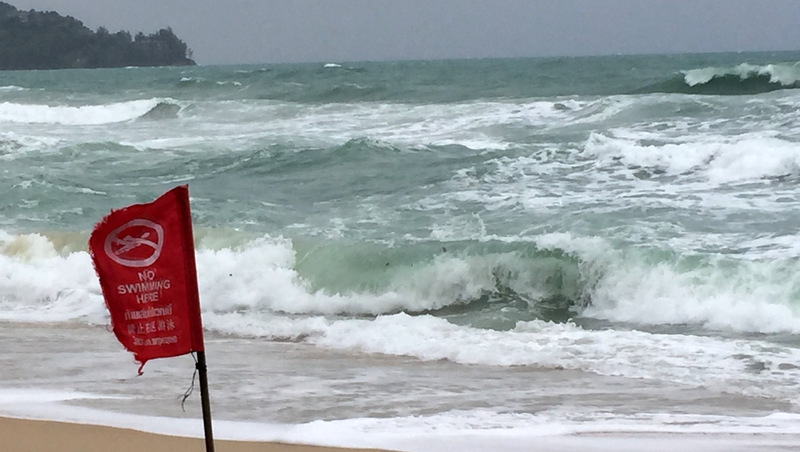Four people have drowned over the past five days along Phuket’s west coast. Some of the beaches have potentially dangerous rips that should be understood by anyone considering going into the water at this time of the year at Phuket’s west coast beaches.
Here’s some advice from Associate Professor Robert Brander, PhD, Coastal Geomorphologist, University of New South Wales and Daren Jenner, a Marine Safety Officer, International Surf Lifesaving Association.
Rip currents are strong, narrow seaward flowing currents, like ‘rivers of the sea’, that can develop on beaches when waves are breaking across wide areas. These currents are also responsible for the vast majority of beach rescues by lifeguards around the world, and are the main cause of beach-related drownings.
Phuket is no exception, as rip currents exist on many beaches during the monsoon season from May to November, and numerous people, usually tourists, have been caught in rips and drowned. Karen Beach is notorious for these rips developing on rough days with the south westerly monsoon blowing in.
Studies have shown that most people have a poor understanding of what rip currents are, and more than two-thirds of beachgoers can’t identify what rip currents look like. In Phuket, due to the high tourist population, this number is even higher.
New information brought to light by recent scientific research and experiments in rip currents, now reveals that much of what experts used to believe about them is oversimplified, and has significant implications for how people should actually react if they find themselves caught in a rip current.
What is a rip current?
Rip currents are strong, narrow, seaward flowing currents, that extend from the shoreline, out beyond the breaking waves. They exist to bring all the extra water that is coming in with the breaking waves, back off- shore.
The traditional diagrams about how water flows and circulates in a rip have been in use for decades and typically show rip currents flowing straight out to sea, well offshore of the breaking waves. But recent advances in measuring rips have shown that the old scientific view may not always be an accurate depiction of how rip currents actually work.
Many rips in fact circulate within the surf zone and only extend beyond it occasionally. This suggests that floating, instead of swimming parallel to the beach, may be the best action to take if caught in a rip.
“With this new scientific information, we have learned that our old ideas, and the strategies we used to teach about effectively escaping rip currents, may need to be reconsidered.
Prevention
The first and best strategy for swimmers to use to survive rip currents is prevention. The only effective method to keep ocean users safe from rips 100% of the time, is to avoid them completely. Swimming at a beach patrolled by trained lifeguards, and knowing how to spot these currents yourself, are the two most important actions anyone can take to avoid drowning in rips.
Whilst many of Phuket’s most popular west-coast beaches are routinely patrolled by lifeguards, they are not always on duty, and not always exactly where you may be choosing to swim. There’s hundreds of tourists on a beach and only a few of them.
A red-and-yellow flag means that the area is under patrol and is safe to swim. Staying in-between these flags while in the water is the best way to avoid rip currents on the Island. If a beach in Phuket does not have these flags flying, beach users are advised NOT to enter the water. If there are red flags along the shore DO NOT go swimming in that area.
The reality is that swimmers caught in a rip may need to make a series of decisions to escape, rather than simply remembering the old slogan of “swimming parallel to the shore in either direction.” Escaping rips may require a combination of floating and swimming.

If you are caught in a rip the most important strategy is not to panic.
The challenge for swimmers that need to self-rescue is they must remain calm, float to conserve energy, and assess their situation.
“It is imperative to avoid the natural urge to swim against the current back to shore. This is so important because it is panic that drowns people, not rip currents. Rips do not pull people under the water, or take them across the ocean, they simply take people for a ride.”
If a beachgoer does enter the water at a secluded or unguarded beach, and finds themselves being pulled out by a rip, it may be necessary for them to try and help themselves.
How to self-rescue from a rip
• Relax. The rip current won’t pull you under, it just takes you for a ride
• Stay afloat and think about your situation. If there are lifeguards or surfers around, signal for help. Or get the attention of someone on the beach who can go seek help
• You can choose to keep floating as there is a chance the rip current flow may re-circulate back into shallow water in 5-10 minutes. You are also conserving your energy
• If you want to swim out of the rip current, look around you for the nearest area of breaking waves and whitewater. Most rips are quite narrow and the whitewater means it’s shallower and you may be able to stand up
• Conserve energy by swimming slowly towards that area. If no progress is being made, swim in another direction towards the next-closest shallow area with breaking waves.
• Once the waves start to break around you, swim with them toward the beach.
• When you can touch the bottom, walk to shore, avoiding deeper water if possible.
Types of rip currents and how to spot them
You don’t cross a road without looking both ways and you should never go to a beach with lots of waves without thinking about rip currents. Always spend five minutes looking at the surf trying to spot rips, or ask a lifeguard or surfer if there are any rip currents present and get them to point them out to you.
Rip currents sometimes circulate as rotating eddies, in which case floating is a good escape strategy. They can also extend well beyond the line of breaking waves, in which case a long swim along the beach is required to make it back to shore.
Always spend five minutes looking at the surf trying to spot rips, or ask a lifeguard or surfer if there are any rip currents present and get them to point them out to you.
Dr. Rob Brander is a coastal geomorphologist and Associate Professor in the School of Biological, Earth and Environmental Sciences at the University of New South Wales in Sydney, Australia. He has been studying beaches and surf science since 1986.









